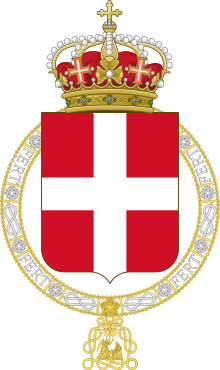House of Savoy
The House of Savoy was the ruling dynasty of the Duchy of Savoy, then the Kingdom of Sardinia and later Kingdom of Italy from 1861 to 1946.
| House of Savoy | |
|---|---|
 The coat of arms of the Savoy family while monarchs of Italy. | |
| Details | |
| Adopted | 17 March 1861, Proclamation of the Kingdom of Italy |
The House of Savoy began in Switzerland in the Middle Ages. The Savoy rose to power in Sicily War of Spanish Succession then gave up Sicily for Sardinia in 1720 later adding Piedmont to their kingdom.
In 1792 they joined the alliance against Napoleon Bonaparte. They were defeated at first but had their kingdom restored after Napoleon was defeated.
In 1859, King Victor Emmanuel II led the unification of Italy and ruled until 1878. His grandson Victor Emmanuel III came to power in 1900 after King Umberto I was assassinated. Victor Emmanuel III was king during both World War I and World War II. He also appointed Benito Mussolini Prime Minister in 1922.
After World War II, public support for the monarchy fell and Victor Emmanuel III abdicated in 1946. His son Umberto II was king for a month before a referendum abolished the monarchy. Today the leadership of the House of Savoy is contested between Victor Emmanuel, Prince of Naples, who is the son on Umberto II, and his cousin Prince Amedeo, Duke of Asota.
There was also a branch of the family that settled in France they were known as the Dukes of Nemours and often had close ties with the Court of Louis XIV.
From 2006 until his death in 2021, Prince Amedeo, Duke of Aosta was the disputed head of the House of Savoy.
Related pages
change